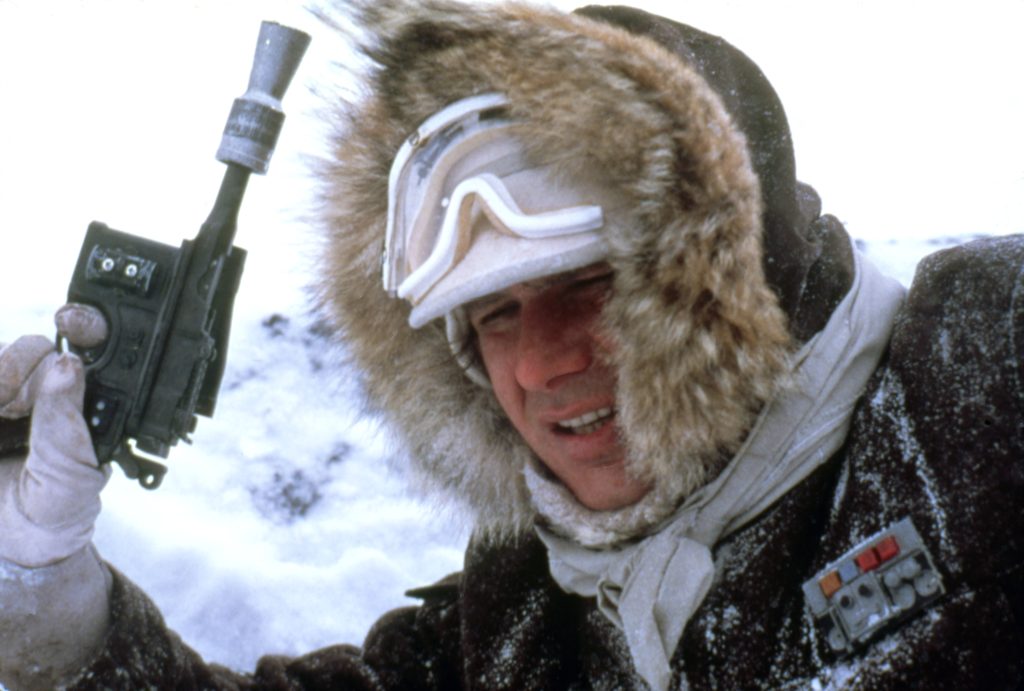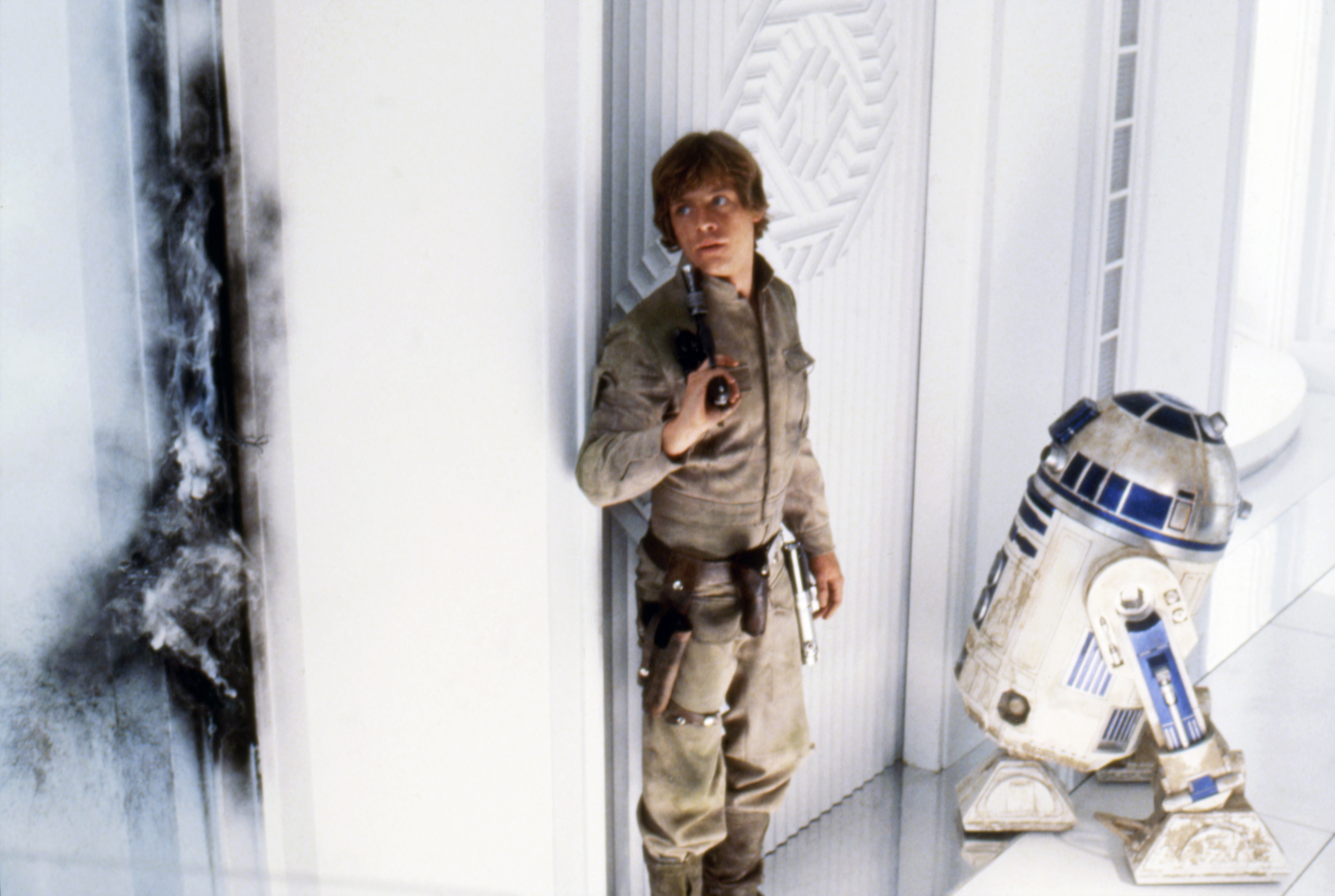The battle for the galaxy intensifies as the Rebel Alliance finds itself on the run from an Empire more determined than ever. “The Empire Strikes Back” doesn’t just continue the Star Wars saga—it elevates it to unprecedented heights with shocking revelations, deeper character development, and a bold ending that defied Hollywood conventions. Nearly half a century later, this middle chapter remains the pinnacle of the franchise and a masterclass in sequel filmmaking.
Quick Summary Box
| Category | Details |
|---|---|
| Movie Name | Star Wars: Episode V – The Empire Strikes Back (1980) |
| Director | Irvin Kershner |
| Cast | Mark Hamill, Harrison Ford, Carrie Fisher, Billy Dee Williams, Anthony Daniels |
| Genre | Science Fiction, Adventure, Fantasy |
| IMDb Rating | 8.7/10 ⭐ |
| Duration | 2h 4m |
| Where to Watch | Disney+, Digital rental platforms |
| Release Date | May 21, 1980 |
Introduction: The Sequel That Defined a Franchise
When “Star Wars” exploded onto screens in 1977, it revolutionized filmmaking and popular culture. Three years later, George Lucas took the bold step of handing directorial duties to Irvin Kershner while maintaining creative control as executive producer and story architect. The result was a darker, more emotionally complex film that expanded the Star Wars universe in ways fans couldn’t have imagined. With its stunning visual effects, iconic musical score by John Williams, and one of the greatest plot twists in cinema history, “The Empire Strikes Back” transcended its status as a sequel to become the standard against which all follow-ups are measured. More than four decades later, its influence on filmmaking, storytelling, and popular culture remains as powerful as the Force itself.
Plot: Rebellion on the Run
Following the Rebel Alliance’s destruction of the Death Star, the Empire has launched a massive campaign to crush the rebellion once and for all. The film opens with Imperial forces, led by Darth Vader, discovering the hidden Rebel base on the ice planet Hoth. After a devastating battle, the Rebels are forced to evacuate, with our heroes separating on different paths.
Han Solo (Harrison Ford), Princess Leia (Carrie Fisher), Chewbacca, and C-3PO flee in the damaged Millennium Falcon, eventually seeking refuge with Han’s old friend Lando Calrissian (Billy Dee Williams) in Cloud City. Meanwhile, Luke Skywalker (Mark Hamill) and R2-D2 travel to the swamp planet Dagobah, where Luke trains in the ways of the Force under the enigmatic Jedi Master Yoda.
As the Empire relentlessly pursues the Millennium Falcon, setting a trap in Cloud City with the help of a reluctant Lando, Luke experiences disturbing visions of his friends in danger. Against Yoda’s warnings, he abandons his training to rescue them, leading to a confrontation with Darth Vader that ends with a devastating revelation and the capture of Han Solo by bounty hunter Boba Fett. The film concludes not with triumph, but with our heroes defeated and scattered, clinging to the hope of eventual reunion and victory.
Performance Analysis: Characters Under Pressure
“The Empire Strikes Back” benefits enormously from deeper character development across the board. Mark Hamill evolves Luke from an eager farm boy to a conflicted hero-in-training, conveying the character’s growth through subtle changes in his demeanor and confidence. Harrison Ford cements Han Solo as cinema’s quintessential rogue with heart, adding layers of vulnerability beneath his cocky exterior, particularly in his developing relationship with Leia.
Carrie Fisher brings new dimensions to Princess Leia, balancing her leadership responsibilities with her emerging feelings for Han, creating one of cinema’s most memorable romantic dynamics. Their exchange—Han’s “I love you” met with Leia’s “I know”—has become iconic precisely because Fisher delivers the line with such perfect emotional complexity.
But it’s the new additions to the cast that truly elevate the film. Frank Oz’s puppetry and voice work bring Yoda to life with remarkable depth and wisdom, creating a character so convincingly real that audiences forget they’re watching a puppet. Billy Dee Williams infuses Lando Calrissian with charisma and moral complexity as a man forced to make impossible choices. And though mostly hidden behind a mask, David Prowse’s physicality combined with James Earl Jones’s resonant voice make Darth Vader even more menacing than in the original film, transforming him from simply a villain to a figure of tragic depth.
Visual Storytelling: Expanding the Galaxy

Director Irvin Kershner and cinematographer Peter Suschitzky bring a visual sophistication that builds upon the groundbreaking effects of the original while establishing distinct environments that have become iconic in the Star Wars universe. The stark white expanses of Hoth, the murky swamps of Dagobah, and the art deco-inspired elegance of Cloud City each create different atmospheric moods that reflect the emotional states of our characters.
Industrial Light & Magic’s special effects reached new heights of innovation, particularly in the asteroid field sequence and the climactic lightsaber duel. Unlike many effects-heavy films of its era, “Empire” maintains a tangible, lived-in quality to its world, using practical effects, detailed models, and innovative stop-motion techniques to create sequences that still impress in the CGI age.
The action sequences, particularly the Battle of Hoth with its towering AT-AT walkers, set new standards for scale and choreography in science fiction cinema. Yet Kershner never lets spectacle overwhelm story, maintaining intimate character focus even during the most elaborate set pieces. The film’s visual language consistently serves its emotional narrative, creating a perfect marriage of technical achievement and storytelling craft.
Thematic Richness: Darkness and Growth
While maintaining the mythic structure established by Lucas, “Empire” introduces more complex themes:
Failure and Resilience: Unlike the triumphant conclusion of “A New Hope,” “Empire” shows our heroes experiencing profound failure. Luke fails in his premature confrontation with Vader, Han is captured, and the Rebellion is scattered. Yet in these failures, the characters discover inner strength and determination that mere victory could never have revealed.
Identity and Heritage: The revelation of Luke’s parentage creates the saga’s central identity crisis. Beyond its shock value, this twist forces both Luke and viewers to reconsider everything they thought they understood about good and evil in this universe.
Sacrifice and Choice: Throughout the film, characters must make difficult choices about what they’re willing to sacrifice. Han chooses to stay with Leia rather than pay off Jabba, Lando betrays his friends before choosing redemption, and Luke must decide between completing his training and rescuing his friends.
Faith vs. Pragmatism: The film presents a fascinating dialogue between Yoda’s mystical approach to the Force and Han’s pragmatic “hokey religions” perspective. Neither viewpoint is entirely validated or dismissed, creating a nuanced exploration of different ways of understanding the universe.
Cultural Impact: Changing Sequel Filmmaking Forever
“The Empire Strikes Back” revolutionized the concept of the sequel in Hollywood. Before “Empire,” sequels were typically diminished retreads of original films, but Kershner and Lucas demonstrated that a second chapter could deepen mythology, complicate characters, and leave audiences with more questions than answers. Its influence can be seen in countless middle chapters of film trilogies that opt for darker tones and cliffhanger endings.
The film’s dramatic reveals fundamentally changed how studios approached spoilers and plot security. “I am your father” remains perhaps the most quoted and parodied line in cinema history precisely because it represented such a seismic shift in the narrative. Modern blockbuster franchises’ obsession with plot secrecy can be traced directly back to the impact of this moment.
Beyond its filmmaking influence, “Empire” cemented Star Wars as a cultural phenomenon rather than a one-off success. The expanded merchandise, deepened lore, and growing fan community around the film established the template for modern transmedia franchises where the story extends far beyond the screen.
The Film’s Legacy: The Gold Standard
More than four decades later, “The Empire Strikes Back” remains the high-water mark of the Star Wars franchise and the film that transformed a popular space adventure into a multi-generational cultural touchstone. Its perfect balancing of spectacle with intimate character development, its willingness to embrace darkness and complexity, and its confident expansion of the original’s mythology created the template that all subsequent entries in the saga have attempted to follow.
For filmmakers, “Empire” demonstrates the possibilities of the blockbuster form—proving that commercial cinema can be artistically ambitious, emotionally resonant, and visually innovative while still entertaining mass audiences. Its influence extends far beyond science fiction, affecting how filmmakers approach everything from sequel structure to character development to visual worldbuilding.
Most remarkably, despite countless viewings and its plot twists becoming common knowledge, the film retains its emotional power. Each new generation discovering the film finds themselves carried away by its perfect pacing, invested in its complex characters, and moved by its exploration of heroism in the face of overwhelming odds.
Conclusion: The Perfect Middle Chapter
“The Empire Strikes Back” succeeds not just as a brilliant sequel but as a masterful film in its own right. By deepening the mythology, complicating its characters, and embracing narrative risk, it elevated Star Wars from an exceptional space adventure to a modern myth with lasting resonance. Like Inception, which brilliantly balanced high-concept ideas with emotional stakes, “Empire” demonstrates how genre filmmaking at its best can combine spectacle with substance.
What makes “Empire” particularly remarkable is how it functions as a middle chapter that feels satisfying despite its cliffhanger ending. The film resolves enough emotional arcs to provide satisfaction while opening new questions that create genuine anticipation for the finale. This delicate balancing act—providing both closure and openness—represents storytelling at its most sophisticated.
For Star Wars fans, “Empire” remains the pinnacle achievement of the franchise—the film that most perfectly realizes George Lucas’s vision of blending mythology, pulp adventure, and visual innovation. For cinema lovers more broadly, it stands as proof that popular entertainment need not sacrifice depth, complexity, or artistic integrity to captivate mass audiences.
In an era of endless sequels and cinematic universes, “The Empire Strikes Back” remains the gold standard—the rare follow-up that doesn’t just continue a story but elevates it to heights even its creators couldn’t have imagined.
Did You Know?
- George Lucas self-financed the film, taking a significant personal financial risk to maintain creative control
- The original working title was “Star Wars: Chapter II”
- Mark Hamill performed all his own stunts in the lightsaber duel except for a single backflip
- The interior of the Dagobah set was built elevated to allow puppeteers to operate Yoda from below
- Harrison Ford improvised the iconic “I know” response to Leia’s “I love you”
Where to Watch
Available exclusively on Disney+ for streaming subscribers and for digital rental or purchase on major platforms.
If You Enjoyed “The Empire Strikes Back,” You Might Also Like:
- “The Lord of the Rings: The Two Towers” (2002) – Another masterful middle chapter in an epic trilogy
- “The Dark Knight” (2008) – For its similarly dark approach to a beloved franchise
- “Aliens” (1986) – A sequel that expands its predecessor’s world while shifting tone
- “Blade Runner 2049” (2017) – For its patient, visually stunning approach to legacy sequel filmmaking

1 thought on “Star Wars: Episode V – The Empire Strikes Back (1980) Review: The Darkest Chapter That Changed Cinema Forever”